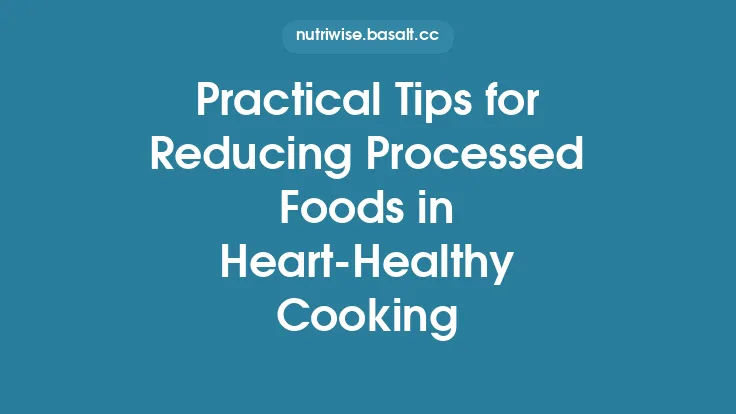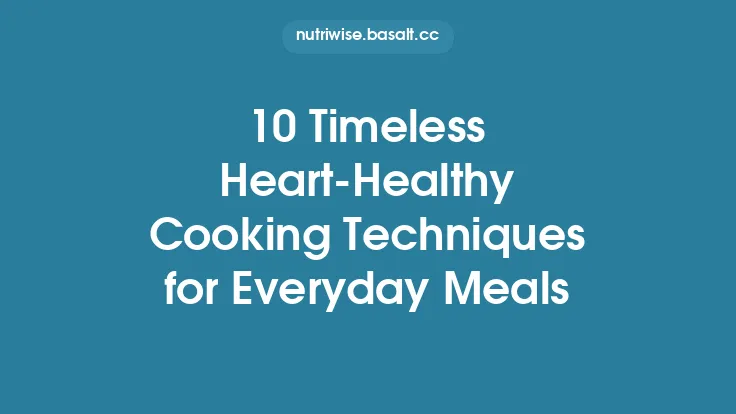Reducing sodium in the kitchen is often perceived as a daunting challenge, especially when the goal is to protect heart health without sacrificing the pleasure of eating. Sodium, while essential for fluid balance and nerve transmission, becomes a risk factor for hypertension and cardiovascular disease when consumed in excess. Fortunately, a wealth of natural, flavor‑building techniques can dramatically lower sodium levels while delivering dishes that are vibrant, satisfying, and heart‑friendly. Below is a comprehensive guide that walks you through the science of sodium, the recommended intake limits, and a toolbox of culinary strategies that let you season with confidence—no added salt required.
Understanding Sodium and Cardiovascular Function
Sodium ions (Na⁺) play a pivotal role in maintaining extracellular fluid volume and generating the electrical impulses that drive heartbeats. However, excess sodium prompts the kidneys to retain water, expanding blood volume and increasing arterial pressure. Over time, this heightened pressure strains the endothelium, accelerates arterial stiffening, and promotes left‑ventricular hypertrophy—key precursors to heart disease.
Research consistently links high dietary sodium with a 20–30 % increase in the risk of stroke and coronary events. The relationship is dose‑dependent: each 1,000 mg reduction in daily sodium intake can lower systolic blood pressure by approximately 2–3 mm Hg in hypertensive individuals. Understanding this physiological backdrop underscores why even modest sodium cuts can translate into meaningful cardiovascular protection.
Recommended Sodium Intake and How to Gauge Your Consumption
| Population | Recommended Upper Limit* | Typical Average Intake |
|---|---|---|
| General adult | 2,300 mg (≈ 1 tsp salt) | 3,400 mg – 4,800 mg |
| Hypertensive, older adults, African‑American, CKD | 1,500 mg | — |
| Athletes with heavy sweat loss | Up to 3,000 mg (context‑specific) | — |
\*Guidelines from the American Heart Association and Dietary Guidelines for Americans.
To gauge personal intake, keep a simple log for a week: note the sodium content of packaged items (found on Nutrition Facts panels) and estimate the sodium contributed by home‑cooked components (e.g., 1 tsp sea salt ≈ 2,300 mg). This baseline reveals hidden sources and informs where reductions will have the greatest impact.
Natural Flavor Foundations: Acidity, Bitterness, Sweetness, and Umami
Flavor perception is a balance of the five basic taste modalities. When salt is reduced, the other tastes can be amplified to maintain overall palatability:
- Acidity (citric, malic, acetic acids) brightens dishes, counteracting blandness.
- Bitterness (from certain vegetables, coffee, cocoa) adds depth; a touch of bitterness can signal complexity without needing salt.
- Sweetness (natural sugars from fruits, carrots, onions) rounds flavors and masks mild salt loss.
- Umami (glutamate‑rich foods) provides a savory richness that often substitutes for salt’s “meaty” quality.
By deliberately adjusting these taste pillars, you can create a harmonious flavor profile that feels complete even when sodium is dramatically lowered.
Harnessing Umami Without Salt: Ingredients and Techniques
Umami is the most powerful ally in sodium reduction. Below are natural, low‑sodium sources and how to integrate them:
| Ingredient | Approx. Natural Glutamate (mg/100 g) | Application |
|---|---|---|
| Sun‑dried tomatoes | 1,200 | Rehydrate and blend into sauces |
| Mushrooms (shiitake, porcini) | 800–1,100 | Sauté, dehydrate, or use as a powder |
| Seaweed (kombu, nori) | 1,000–1,500 | Simmer in broths, crumble over salads |
| Aged cheeses (Parmesan, Pecorino) – use sparingly | 1,200 | Finish dishes for a burst of flavor |
| Fermented soy products (tamari, miso) – low‑sodium versions | 1,000 | Stir into soups, marinades, or dressings |
Technique tip: Toast mushrooms or seaweed before adding them to a dish. The Maillard reaction intensifies umami compounds, allowing you to use less overall quantity while achieving a richer taste.
Citrus, Vinegar, and Fermented Acids as Salt Replacements
Acidic components can mimic the “sharpness” that salt provides:
- Citrus juices (lemon, lime, orange) add a fresh, tangy lift. A tablespoon of lemon juice can replace up to ¼ tsp of salt in dressings.
- Vinegars (apple cider, rice, balsamic) contribute both acidity and subtle sweetness. Reducing a vinaigrette’s salt by half and adding a splash of balsamic can preserve balance.
- Fermented acids (sauerkraut juice, kimchi brine) bring complex sour notes plus probiotic benefits. Use sparingly to avoid excess sodium from the brine, but the depth they add often eliminates the need for added salt.
When using acids, add them toward the end of cooking to preserve brightness and prevent bitterness.
Textural Enhancements that Reduce Salt Perception
Mouthfeel influences how we perceive saltiness. Introducing contrasting textures can make a dish feel more satisfying, reducing the urge for extra salt:
- Crisp elements (toasted nuts, seeds, panko) add a satisfying crunch.
- Creamy components (avocado purée, Greek yogurt, cashew cream) coat the palate, delivering a perception of richness that can mask lower sodium.
- Caramelized surfaces (roasted vegetables, seared proteins) develop sweet‑savory notes through browning, enhancing overall flavor complexity.
By thoughtfully layering textures, you create a multisensory experience that distracts from reduced sodium levels.
Low‑Sodium Stock, Broth, and Sauce Production
Commercial broths often contain 600–1,200 mg of sodium per cup. Making your own low‑sodium base is straightforward:
- Select a sodium‑light foundation: Use water with a pinch of potassium chloride (optional) as the liquid base.
- Build flavor with aromatics: Onion, carrot, celery, garlic, and bay leaf contribute depth without salt.
- Add umami boosters: A handful of dried mushrooms, a strip of kombu, or a splash of low‑sodium soy sauce (≤ 300 mg per tbsp) intensify the broth.
- Simmer gently: 30–45 minutes extracts flavors while preserving delicate nutrients.
- Strain and store: Portion into freezer bags for quick use.
For sauces, replace salty condiments with a blend of roasted tomato purée, a dash of balsamic vinegar, and a pinch of smoked paprika to achieve a robust, savory profile.
Salt‑Free Seasoning Blends and the Role of Potassium‑Based Substitutes
While herbs and spices are the obvious go‑to, you can craft salt‑free blends that emphasize other taste dimensions:
- Citrus‑pepper blend: Dried lemon zest, cracked black pepper, and a pinch of smoked paprika.
- Umami‑rich mix: Dehydrated mushroom powder, nutritional yeast, and a touch of seaweed flakes.
- Sweet‑heat combo: Ground cinnamon, a pinch of cayenne, and a drizzle of maple syrup (added at the end).
Potassium chloride (often marketed as “salt substitute”) can mimic salt’s ionic crunch but delivers potassium instead of sodium. Use it cautiously: individuals with kidney disease or those on potassium‑sparing diuretics should consult a healthcare professional before incorporating it regularly.
Cooking Methods that Concentrate Flavor
Certain techniques naturally amplify taste, allowing you to rely less on added salt:
- Roasting: Caramelizes natural sugars and concentrates savory notes. Toss vegetables with a drizzle of olive oil and a splash of balsamic before roasting.
- Grilling: The Maillard reaction on the grill creates smoky, umami‑rich crusts. Marinate proteins in acid‑based mixtures to keep them moist.
- Searing: A quick, high‑heat sear on meat or tofu creates a flavorful crust that reduces the need for seasoning.
- Deglazing: After sautéing, add a splash of wine, citrus juice, or broth to dissolve browned bits (fond). This liquid becomes a flavorful base for sauces.
By employing these methods, you let the food’s own chemistry do the heavy lifting in flavor development.
Managing Sodium in Specific Food Categories
| Category | Sodium‑Reduction Tactics |
|---|---|
| Legumes (beans, lentils) | Rinse canned varieties thoroughly (up to 3×) to remove up to 40 % of sodium; cook dried beans with a bay leaf and a splash of apple cider vinegar for brightness. |
| Whole‑grain products (brown rice, quinoa) | Cook in low‑sodium broth infused with citrus zest; finish with a drizzle of toasted sesame oil for depth. |
| Poultry & meat | Brine in a solution of water, a pinch of potassium chloride, and herbs; the brief brine adds moisture without excess sodium. |
| Seafood | Use acid marinades (lime juice, ginger) and a dash of low‑sodium fish sauce to highlight natural brininess. |
| Dairy | Opt for plain Greek yogurt or low‑fat cottage cheese; add a squeeze of lemon and a sprinkle of smoked paprika for a savory twist. |
These targeted adjustments keep each food group flavorful while staying within heart‑healthy sodium limits.
Monitoring Sodium Through Label Literacy
Even when cooking from scratch, packaged ingredients can sneak sodium into a recipe. When reading Nutrition Facts:
- Check the “Sodium per serving” and calculate the amount per recipe portion.
- Look for “No Salt Added” or “Low Sodium” designations, but still verify the actual milligram count.
- Beware of “Reduced Sodium” claims; they may still contain ½ tsp of salt per serving.
- Consider the ingredient list: terms like “sodium bicarbonate,” “sodium nitrate,” “monosodium glutamate (MSG),” and “sodium benzoate” contribute to total sodium.
By consistently applying these checks, you maintain control over the cumulative sodium load of your meals.
Integrating Sodium‑Reduction Strategies into Everyday Meal Planning
- Batch‑cook low‑sodium stocks and freeze in portioned containers; use as the base for soups, stews, and grain cooking water.
- Create a “flavor pantry” of dried umami ingredients (mushroom powder, seaweed flakes) and acid concentrates (citrus zest, vinegar) for quick seasoning.
- Plan a “salt‑swap” day each week where you intentionally replace a traditionally salty component (e.g., soy sauce) with a low‑sodium alternative plus an umami booster.
- Taste before you salt: after cooking, let the dish rest for a few minutes, then assess flavor. Often the perception of blandness fades, revealing that the dish is already well‑balanced.
- Track progress: keep a simple spreadsheet of daily sodium intake and note which strategies you used. Over time, you’ll see patterns and can refine your approach.
Reducing sodium naturally is not about sacrificing taste; it’s about re‑educating the palate and leveraging the full spectrum of flavors that nature provides. By understanding the physiological impact of sodium, embracing umami, acidity, and texture, and employing cooking methods that concentrate taste, you can craft meals that delight the senses while nurturing a stronger, healthier heart. The journey begins with a single mindful adjustment—each subsequent step builds a culinary repertoire that proves flavor and heart health can coexist beautifully.





